eISSN: 2577-8307


Research Article Volume 3 Issue 3
1District Institute for Education and Training (DIET), India
2Department of Forestry, Wildlife and Environmental Sciences, Guru Ghasidas University, India
3Department of State Forest, Jhelum Valley Forest Division Baramulla, India
4Department of Forestry, Guru Ghasidas University, India
Correspondence: Shyam Shanker Singh, Professor, Department of Forestry, Wildlife and Environmental Sciences, Guru Ghasidas University, Bilaspur, CG, India
Received: December 06, 2018 | Published: July 2, 2019
Citation: Rawat VS, Singh SS, Wani MR, et al. Potential of fractionated doses of gamma rays to stimulate growth and yield of amaranthus caudatus in M1 (First filial generation) and M2 (Second filial generation) generation. Forest Res Eng Int J. 2019;3(3):77-82. DOI: 10.15406/freij.2019.03.00081
The increasing demand of convenience, wholesome and health promoting foods has resulted in search of new technologies to improve the yield of agriculture crops. The present study investigate the influence of fractionated gamma irradiation doses on germination, growth and yield of Amaranthus caudatus; a potential plant in food and medicinal industry. The air dried seeds of A. caudatus were exposed to different set of gamma irradiation doses (10KRF, 20KRF, 40KRF and 80KRF) using 60 Co source. For fractionated treatment, it was done by fractionating the doses in two equal parts by allowing an interval of 24 hours between two equal doses. Treated and untreated seeds were sown in a uniform soil medium. The whole experiment was arranged in a complete randomized block design, and the observations were taken upto M2 generation. The gamma irradiations significantly (p≤0.05) alter the germination energy index in M1 and M2 generations. In contrast, the germination percentage didn’t show any significant difference. The highest percentage of survival was recorded under 20KRF treatment in both M1 and M2 generations. The maximum yield per plant in M1 and M2 generations was recorded by 20KRF gamma irradiation treatment. The different growth parameters were significantly (p≤0.05) enhanced in both M1 and M2 generations, by the gamma irradiation treatments in a dose dependent manner. Also, it was observed that the growth and yield in M2 generation across all doses was better than M1 generation. The present study demonstrated that the fractionated gamma irradiation treatments can be used as a novel approach to enhance the growth and yield of A. caudatus.
Keywords: Amaranthus caudatus, fractionated doses, growth, yield, M1 (first filial generation) and M2 (second filial generation) generation
Mutation breeding is one of the prevalent breeding methods in plant breeding. It is relevant with various fields like, cytogenetics, biotechnology, morphology, and molecular biology. Mutation breeding has become as an efficient tool for crop improvement. Mutagens may directly influence on the genetic makeup of an organism and produce new promising traits for the improvement of crop plants.1 Across all the crop improvement techniques, trait based improvement through gamma irradiation technology shown a possible gain within less time. Gamma rays have a potential to influence plant growth and development by altering the functioning of plant cells.2 The gamma irradiation technology was found successful in developing improved characteristics of agriculture crops.3,4 Through gamma induced mutation breeding a barley variety was developed having early maturity, producing high yield, with high protein contents and having stiff straw.5
There are some reports which indicate that the higher dose levels of gamma irradiation were inhibitory,6−8 in contrast the lower gamma irradiation doses having a potential of stimulatory influence.9 The gamma rays being the most energetic and having high penetrating influence in comparison to other radiations.10 This property of gamma irradiations has made its suitability in crop improvement programmes. During the interaction of gamma rays with atoms and molecules it produces free radicals in cells. These radicals produced by gamma rays can inhibit or modify the components of plant cells, which results in the alteration of morphology, anatomy, biochemistry and physiology of plants depending on the exposure of irradiation level. Many potential mutations were developed through gamma irradiation technology in agriculture crops.6,7 Taking in consideration the potential of gamma irradiation technology on the trait based modification of plants. The present study was designed, with the aim to determine the influence of gamma irradiations on germination, growth and yield of A. caudatus in M1 and M2 filial generations.
The air dried seeds of Amaranthus caudatus collected from healthy plants were exposed to different does of gamma irradiations (10KR, 20KR, 40KR & 60KR) using6 Co gamma source The selection of gamma irradiation doses was done on the bases of previous studies, where significant results were obtained.8,9 The seeds were irradiated by fractionated pattern. For fractionated doses, it was done by fractionating the doses in two equal parts by allowing an interval of 24 hours between two equal doses. In this way it has been tried to compare the pace of DNA repairing mechanism by comparing the different germination and growth attributes under influence of gamma irradiations in continuous and fractionated pattern.
For each gamma irradiation treatment on hundred seeds were considered. The control set was not given any irradiation treatment, and finally the results of irradiated seeds were compared to untreated seeds. Each treatment group (both treated and untreated seeds) were replicated four times, with 25 seeds in each replicate. The experiment was arranged in a randomized block design (RBD) i.e, the number of treatments in this design is equal to the number of replicates. In this design, the treatments are allocated to the experimental units or plots in a manner within homogeneous blocks or replications. For studying the germination and early growth behaviour the experiment was carried out in petridishes in a uniform environment. Whatmann filter paper No. 1 was used for petridishes. The treated and untreated seeds were also grown in the field in first week of May for studying the detail growth behaviour. To observe the transmission of the modifications induced by gamma irradiations, the experiment was carried up to second filial generation (M2 generation). In experimental mutagenesis the plants obtained directly from the seeds treated with a mutagen are considered as M1 filial generation, and the plants obtained from the seeds of M1 filial generation are considered as M2 filial generation.
The germination of seeds was recorded when the emergence of radical was 2mm long.11 Germination percentage (GP), germination energy index (GEI),12 and germination value (GV) was calculated from daily germination record.13
Observations of leaf growth shoot growth, and root growth was recorded up to the final day of experiment. At the last average yield per plant was recorded after at the harvesting time of the plants. The fresh and dry weight of seedling from each treatment group was calculated at the last day of experiment.
The data obtained under the treated and untreated group was subjected to analysis of variance (ANOVA) by using SPSS software. In order to determine the variation across different treatments, the Duncan’s Multiple Range 14 at (p≤0.05) level of significance was used.
The effect of fractionated doses of gamma irradiation on germination of Amaranthus caudatus is given in Figure 1 & 2. The obtained result show that the germination percentage doesn’t differ significantly both in M1 and M2 filial generations across different gamma irradiation treatments. However, germination energy index vary significantly (p≤0.05) across different gamma irradiation treatments in both first and second filial generations.60KRF gamma irradiation dose recorded maximum germination energy index (100±0.67) in first filial generation than the control. It was also seen that the germination energy index was higher under all the tested doses in second filial generation than first filial generation respectively. In both M1 and M2 generation the lower gamma irradiation doses (up to 20KRF) doesn’t record any significant alteration in the germination value of A. caudatus than its respective control group. Stimulation in the germination value was observed by the different gamma irradiation treatments over the control in both M1 & M2 generation. This potential of fractionated doses in enhancement of germination behaviour can be correlated with the potential increase in the enzymatic activation system (Figure 3 & 4).15
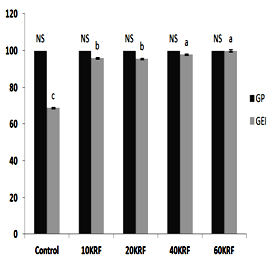
Figure 1 Influence of fractionated doses of gamma rays on germination percentage and germination energy index value (M1 filial generation) in Amaranthus caudatus.

Figure 2 Influence of fractionated doses of gamma rays on germination percentage and germination energy index value (M2 filial generation) in Amaranthus caudatus

Figure 3 Influence of Fractionated doses of gamma rays on germination value (M1 filial generation) in Amaranthus caudatus
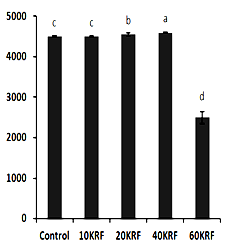
Figure 4 Influence of Fractionated doses of gamma rayson germination value (M2 filial generation) in Amaranthus caudatus.
Fresh weight of seedlings was stimulated by different fractionated gamma irradiation treatments (Figure 5 & 6) in M1 and M2 generation.The seedling fresh weight was recorded maximum by 10KRF treatment (Figure 5) than the control in first filial generation(M1 generation), however in second filial generation(M2 generation) the maximum seedling fresh weight was obtained under 20KRF treatment group (Figure 6) than its control. The dry weight of the seedlings across different treatment groups doesn’t differ significantly in both first filial generation(M1 generation) and second filial generation(M2 generation). A same type of trend was observed in A. julibrissin.9 Higher doses of gamma irradiation inhibit the seedling growth and biomass remarkably by reduction of mitotic activity.16,17 whereas low doses of gamma irradiation could be used as safer and more stimulatory tools to improve these plant growth attributes.18,19

Figure 5 Amaranthus caudatus-- Fresh weight and dry weight of seedling as influenced by different fractionated doses of gamma rays after 7 days (M1 generation).
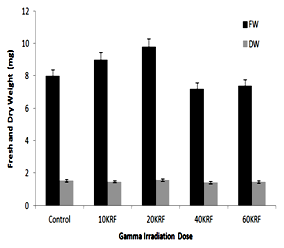
Figure 6 Amaranthus caudatus-- Fresh weight and dry weight of seedling as influenced by different fractionated doses of gamma rays after 7 days (M2 generation).
The significant increase (p≤0.05) in survival percentage was noticed in a dose dependent manner (Figure 7 & 8) for both first filial generation (M1 generation) and second filial generation (M2 generation). In first filial generation (M1 generation) except 20KRF and 40KRF, all the tested doses increased the mortality rate of seedlings, and the maximum mortality was recorded by 60KRF treatment respectively. In second filial generation (M2 generation) all the doses don’t show any significant alteration in survival percentage except 60KRF dose (Figure 7 & 8).
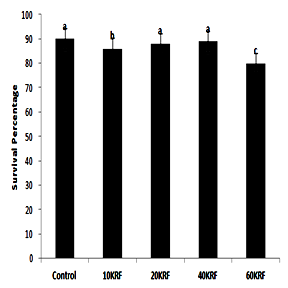
Figure 7 Amaranthus caudatus-Survival percentage as influenced fractionated doses of gamma rays (M1 generation).
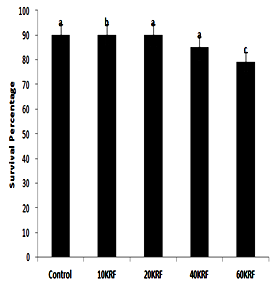
Figure 8 Amaranthus caudatus-Survival percentage by different as influenced by different fractionated doses of gamma rays (M2 generation).
10KRF gamma irradiation dose significantly stimulated (p≤0.05) the average grain yield of each plant (Figure 9 & 10) in comparison to control. The other gamma irradiation doses don’t record any significant alteration in first filial generation (M1 generation) than the control. In second filial generation (M1 generation) all the gamma irradiation treatments except 60KRF, significantly stimulated the average grain yield per plant. The maximum grain yield was recorded for the plants treated with 20KRF gamma irradiation doses. Such a stimulation in the average grain yield per plant can be correlated to gene compliment,20 which may be activated by the exposure of gamma irradiation at different dose levels. Similar results in the present study were seen in M2 generation thus the foresaid explanation (activation of genes) can be better confirmed. Significant increase of chickpea grain yield using gamma irradiation at 600 Gy was reported.21 Seeds of barley when exposed to the different gamma irradiations doses developed the barley plants with higher yield and early maturity.22 Soybean plants obtained under 20KR gamma irradiation dose reported highest grain yield.23 In the present study the stimulation in average grain yield may be due the increase in the average leaf area through the exposure of 20KRF and 40KRF gamma irradiation doses. The increase in the grain yield can also be correlated with the increase in the average leaf area per plant by 20KRF and 40KRF treatments, which potentially increased the growth rate and hence stimulating the average grain yield of A. caudatus. The application of gamma irradiation treatments can be utilized in stimulating the yield of A. caudatus at commercial base.
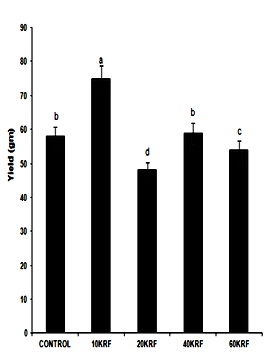
Figure 9 Amaranthus caudatus - Average yield per dose per plantas influenced by different fractionated doses of gamma rays (M1 generation).
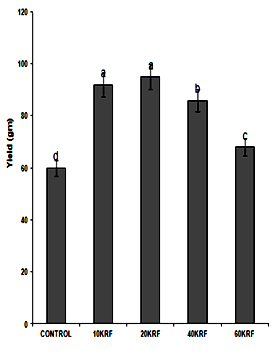
Figure 10 Amaranthus caudatus - Average yield per dose per plant as influenced by different fractionated doses of gamma rays (M2 generation).
In first filial generation (M1 generation) the average shoot and root length per plant doesn’t record any significant alteration by the exposure of gamma irradiation treatments, this indicates the radio-resistance of the plant (Table 1). The average number of leaves and leaf area per plant show a significant enhancement by 40KRF & 60KRF doses respectively (Table 1), in comparison to the Control. Maximum number of branches were formed in the seedlings treated with 60KRF dose, followed by 20KRFthan the control.
Dose |
Average Root Length/plant(cm) |
Average Shoot Length/plant(cm) |
Average No. of Leaves/plant |
Average Leaf Area /plant (cm2) |
Average Leaf length /plant (cm2) |
Average number of branches |
Control |
4.31±0.21a |
145.1±1.02ab |
9.20±0.44c |
8012.1±3.56b |
23.3±0.56a |
7.03±0.37b |
10KRF |
6.22±0.46a |
160.2±2.10b |
9.31±1.21c |
8112.3±5.68b |
24.9±0.94a |
11.3±0.52a |
20KRF |
4.18±0.12a |
162.13±0.94b |
9.40±1.66a |
8212.5±4.21a |
23.2±1.32a |
10.2±0.94a |
40KRF |
5.96±0.35ab |
165.2±1.74b |
11.5±0.87b |
7821.3±6.67a |
22.1±0.17a |
11.1±0.86b |
60KRF |
3.64±0.17a |
163.01±1.09a |
11.6±0.22d |
7014.2±3.54c |
22.9±1.10a |
12.1±0.72c |
ANOVA |
NS |
* |
* |
** |
NS |
* |
One Way |
|
|
|
|
|
|
Table 1 Influence of different doses of gamma radiations (M1filial generation) on different growth parameters after 92days of sowing
Means within a column followed by same letter are not significantly different(P≤0.05). The data shown are mean ± SE of four replicates. Different letters a, b, c and d denote significant difference (p≤0.05) between the treatments.
*Statistically significant at P≤ 0.05
** Statistically significant at P≤0..001
NS- Not Significant
When the plants were observed up to second filial generation (M1 generation) surprisingly the different growth parameters differ significantly across all the treatments in contrast to the Control (Table 2). These results indicate the potential of gamma irradiations in altering the morpho-agronomic traits of A. caudatus up to number of generations. In second filial generation (M2) the shoot and root length were stimulated by 40KRF gamma irradiation dose, than under the control. Such type of stimulation in different growth parameters in different filial generation was also reported.24,25 The plant height of some agricultural crops was stimulated by the influence of gamma irradiations.21,26 The enhancement in the plant height through gamma irradiation treatments may be due to, stimulation of cell division or cell elongation, or alteration in metabolic processes.27 A significant enhancement in the average leaf length and leaf area was obtained across all the tested doses. The plants obtained under 40KRF and 60KRF produced highest number of leaves (Table 2), however the 20KRF and 40KRF doses don’t record any significant difference than the control. The average leaf is in second filial generation (M2) was stimulated by all the gamma irradiation doses and reaching at its peak value under 10KRF dose level (Table 2). The number of branches per plant in second filial generation (M2) was found higher in all tested doses than the control set (Table 2). In Brassica napus the average number of branches were stimulated by lower doses of gamma irradiations.25 There are some reports which suggest that the increase in the number of branches and leaves may be stimulated due to the enhanced production of IAA and Kinetin.28
Dose |
Average Root Length/plant(cm) |
Average Shoot Length/plant(cm) |
Average No. of Leaves/plant |
Average Leaf Area /plant (cm2) |
Average Leaf length /plant (cm) |
Average number of branches |
Control |
4.31±0.21c |
145.09±1.12c |
09.20±0.98b |
8012.12±06.58e |
23.20±0.64c |
7.03±0.24c |
10KRF |
5.04±0.46bc |
182.03±0.94c |
11.19±0.42b |
8279.41±11.42a |
27.30±1.21a |
18.0±0.46a |
20KRF |
5.22±0.12c |
170.04±0.52c |
11.12±1.02b |
8665.35±09.32c |
26.20±0.69c |
14.4±0.21a |
40KRF |
7.43±0.35a |
169.06±2.17a |
14.80±0.69c |
8037.18±06.64b |
25.40±0.32c |
10.0±0.30bc |
60KRF |
5.58±0.17b |
166.09±1.66b |
12.60±1.32c |
8417.12±08.74d |
28.17±0.94b |
11.5±0.25bc |
ANOVA |
* |
* |
* |
** |
* |
* |
One Way |
|
|
|
|
|
|
Table 2 Influence of different doses of gamma radiations (M2 filial generation) on different growth parameters after 92days of sowing
Means within a column followed by same letter are not significantly different (P≤0.05). The data shown are mean ± SE of four replicates. Different letters a, b, c and d denote significant difference (p≤0.05)between the treatments.
*Statistically significant difference at P<0.05
** Statistically significant difference at P<0.001
This study elucidated the response of Amaranthus caudatus to different fractionated doses of gamma irradiations. The germination energy index and growth parameters of A. caudatus were enhanced by gamma irradiation treatments in M1 and M2 generations. The gamma irradiation at 10KRF and 20KRF could play a successful role in increasing the average yield of A. Caudatus in both M1 and M2 generations. Thus these doses can be selected for trait based improvement of A. caudatus for future mutation breeding programmes.
None.
The authors declare that they do not have any conflict of interest.

©2019 Rawat, et al. This is an open access article distributed under the terms of the, which permits unrestricted use, distribution, and build upon your work non-commercially.
This is a modal window.